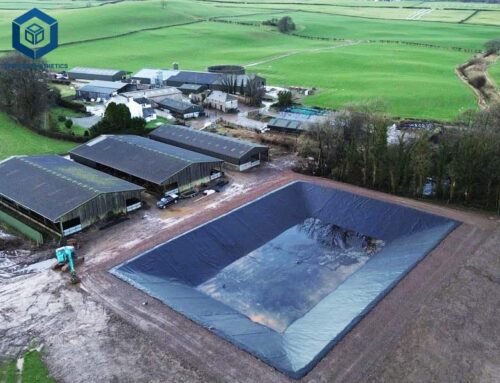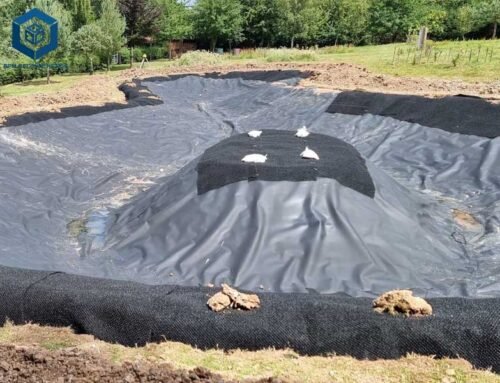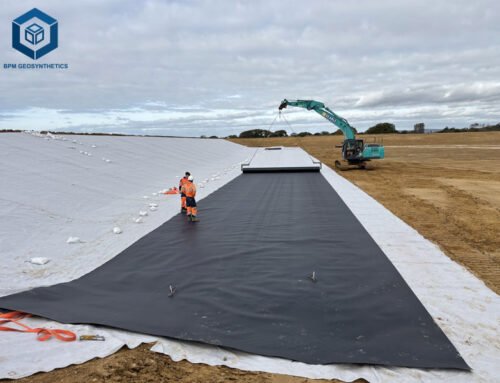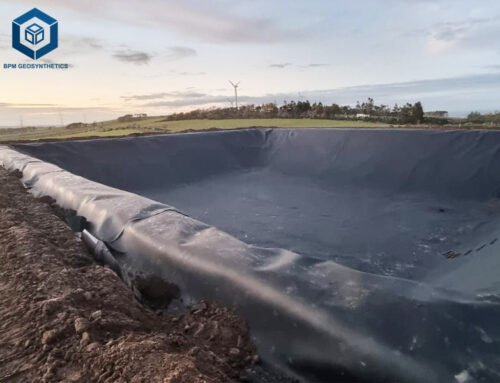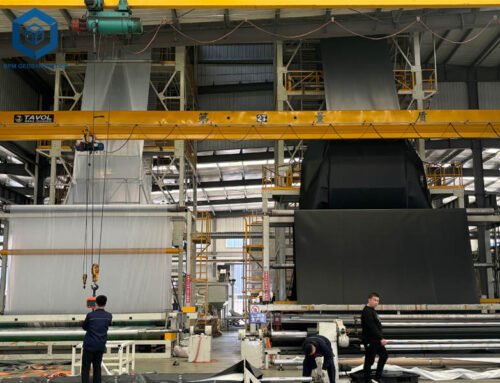Geomembrane 500 micron is a high-performance impermeable liner widely used in environmental, agricultural, and industrial applications for superior containment and waterproofing. With a thickness of 0.5mm, this geomembrane offers an optimal balance between durability, flexibility, and cost-effectiveness, making it ideal for projects requiring reliable seepage control. BPM Geomembrane, a leading manufacturer and supplier, specializes in producing premium-quality 500-micron geomembranes using advanced materials like HDPE, LLDPE, and PVC. These geomembranes are engineered to withstand harsh conditions, including UV exposure, chemical corrosion, and extreme temperatures, ensuring long-term performance in applications such as pond lining, landfill barriers, mining operations, and aquaculture. In this article, we explore the key features, benefits, and diverse uses of Geomembrane 500 Micron, along with why BPM Geomembrane is the trusted choice for global engineering solutions.
1. What Is Geomembrane 500 Micron?
Geomembranes have revolutionized modern engineering as synthetic impermeable barriers designed for fluid containment and environmental protection. These engineered liners play a critical role in preventing seepage, controlling pollution, and ensuring structural integrity across industries. Among the various thickness options available, the 500-micron (0.5mm) geomembrane has emerged as a preferred choice for applications demanding a precise balance between strength, flexibility, and cost-efficiency.
1.1 What Makes a Geomembrane 500 Micron Unique?
A 500-micron geomembrane is a mid-range thickness liner that offers superior performance for moderate-stress applications. Unlike thinner variants (such as 250-micron) that may lack durability or thicker options (like 1mm) that can be cost-prohibitive, the 0.5mm thickness provides an optimal solution for projects requiring reliable containment without unnecessary material excess.
1.2 Key Specifications and Material Composition
The effectiveness of a 500-micron geomembrane depends on its material composition. The most commonly used polymers include:
-
High-Density Polyethylene (HDPE): Known for its chemical resistance and durability, making it ideal for landfill liners and industrial containment.
-
Linear Low-Density Polyethylene (LLDPE): Offers greater flexibility, suitable for uneven surfaces like agricultural ponds.
-
Polyvinyl Chloride (PVC): Used in applications requiring high elongation, such as wastewater lagoons.
-
Ethylene Propylene Diene Monomer (EPDM): Preferred for its weather resistance in exposed applications.
Each material brings distinct advantages, allowing engineers to select the best fit based on environmental conditions and project requirements.
1.3 Thickness Comparison: When to Choose Geomembrane 500 Micron
The choice between geomembrane thicknesses depends on the application’s mechanical and environmental demands:
-
Thinner geomembranes (250-300 micron): Used for lightweight applications like temporary covers or secondary liners where high stress is not a factor.
-
500-micron geomembranes: The sweet spot for moderate-load applications such as aquaculture, irrigation ponds, and secondary containment.
-
Thicker geomembranes (1mm+): Reserved for high-stress environments like mining heap leach pads or primary landfill barriers.
By selecting a 500-micron geomembrane, industries achieve a cost-effective yet durable solution that meets performance needs without over-engineering. This strategic balance is why sectors ranging from agriculture to waste management increasingly rely on this versatile thickness.


2. Why Choose a Geomembrane 500 Micron?
When selecting a geomembrane for your project, understanding its core properties ensures optimal performance and longevity. A 500-micron geomembrane, such as those engineered by BPM Geomembrane, delivers a unique combination of durability, flexibility, and environmental resistance—making it ideal for a wide range of industrial and environmental applications. Below, we explore the critical properties that set this thickness apart.
2.1 Exceptional Durability for Long-Term Performance
A Geomembrane 500 Micron provides superior resistance to:
-
Punctures and tears – The 0.5mm thickness offers enhanced protection against sharp objects and ground movement, making it suitable for landfill liners and mining applications.
-
UV degradation – BPM Geomembrane’s formulations include UV stabilizers to prevent breakdown under prolonged sun exposure.
-
Chemical corrosion – Resistant to acids, alkalis, and hydrocarbons, ensuring reliability in industrial containment and wastewater treatment.
2.2 Optimal Flexibility for Seamless Installation
Unlike thicker geomembranes that may be rigid, a Geomembrane 500 Micron strikes the perfect balance between:
-
Strength – Maintains structural integrity under stress.
-
Conformability – Adapts to uneven surfaces, reducing installation challenges in ponds, canals, and slopes.
This flexibility makes BPM Geomembrane’s 500-micron liners a preferred choice for agricultural and aquaculture projects.
2.3 Low Permeability for Reliable Seepage Control
The Geomembrane 500 Micron ensures minimal liquid transmission, critical for:
-
Water retention in irrigation ponds and reservoirs.
-
Contaminant prevention in hazardous waste containment.
BPM Geomembrane’s precision manufacturing guarantees consistent impermeability, meeting international standards like ASTM and GRI.
2.4 Superior Temperature Resistance for Extreme Climates
Whether in freezing winters or scorching summers, a Geomembrane 500 Micron from BPM Geomembrane performs reliably due to:
-
Thermal stability – Maintains flexibility in cold weather and resists softening in high heat.
-
Weatherproof formulations – Engineered to withstand thermal expansion and contraction without cracking.
3. Where is 500-Micron Geomembrane Most Effective? Key Applications
3.1 Versatile Waterproofing Solutions Across Industries
At BPM Geomembrane, we’ve engineered our 500-micron geomembranes to serve as reliable barriers in numerous critical applications. This optimal thickness provides the perfect balance between performance and cost-efficiency for various containment needs.
3.2 Agricultural Water Management Systems
Our 500-micron geomembranes excel in:
-
Irrigation ponds and water storage reservoirs
-
Canal lining systems to prevent water seepage
-
Livestock watering tanks and runoff containment
The material’s flexibility allows for easy installation on uneven terrain while maintaining excellent puncture resistance against agricultural equipment.
3.3 Waste Management Solutions
BPM’s 500-micron geomembranes play crucial roles in:
-
Secondary landfill liners providing additional protection
-
Leachate collection ponds at waste disposal sites
-
Wastewater treatment lagoons and evaporation ponds
These applications benefit from our geomembranes’ chemical resistance and impermeability, preventing groundwater contamination.
3.4 Hazardous Material Protection
Our clients rely on 500-micron geomembranes for:
-
Secondary containment around oil and chemical storage
-
Spill prevention at fuel depots and industrial plants
-
Process water containment in manufacturing facilities
The material’s durability ensures long-term performance even when exposed to harsh industrial chemicals.
3.5 Cost-Effective Mineral Extraction Solutions
In mining operations, our 500-micron geomembranes serve as:
-
Heap leach pad liners for metal recovery
-
Process solution containment barriers
-
Tailings pond liners for mine waste management
This thickness provides sufficient protection while remaining economical for large-scale mining projects.
3.6 Reliable Water Containment for Fish Farming
BPM’s 500-micron geomembranes are ideal for:
-
Shrimp and fish farming ponds
-
Hydroponic system liners
-
Aquaculture raceway containment
The material’s flexibility accommodates various pond shapes while preventing leaks that could impact production.
4. What Are the Key Challenges When Using Geomembrane 500 Micron? (And How to Solve Them)
4.1 Installation Challenges: Preventing Puncture Risks
While 500-micron geomembranes offer excellent durability, installation presents specific challenges that require careful attention:
4.1.1 Subsurface Preparation is Critical
-
Proper ground compaction and smoothing are essential to prevent sharp protrusions
-
Removal of rocks, roots, and debris from the subgrade surface
-
Use of geotextile underlayment in high-risk areas adds protection
4.1.2 Best Practices During Installation
-
Implement controlled access zones for workers and equipment
-
Use specialized installation tools with rounded edges
-
Conduct regular inspections during deployment
4.2 Combatting UV Degradation for Long-Term Performance
4.2.1 Understanding UV Vulnerability
-
All polymer membranes experience some degree of UV degradation
-
Effects include surface cracking, reduced flexibility, and weakened seams
4.2.2 Effective UV Protection Strategies
-
Carbon Black Additives:
-
Provides inherent UV resistance throughout material thickness
-
Minimum 2-3% carbon content recommended for optimal protection
-
-
Protective Cover Layers:
-
Soil cover (minimum 30cm recommended)
-
Ballast materials like gravel or sand
-
Synthetic cover systems for exposed applications
-
4.3 Chemical and Environmental Compatibility Issues
4.3.1 Material Selection Considerations
-
HDPE formulations excel in harsh chemical environments
-
LLDPE offers better flexibility for dynamic soil conditions
-
PVC provides excellent resistance to a wide pH range
4.3.2 Site-Specific Evaluation Process
-
Conduct comprehensive chemical exposure assessment
-
Analyze soil composition and pH levels
-
Consider temperature extremes and thermal cycling effects
-
Evaluate potential biological factors (microbial activity, root penetration)
4.4 Proactive Maintenance for Extended Service Life
4.4.1 Recommended Inspection Protocols
-
Annual visual inspections for exposed installations
-
Leak detection surveys for critical containment applications
-
Seam integrity testing every 3-5 years
4.4.2 Repair Methodologies
-
Patch welding for small punctures
-
Sectional replacement for extensive damage
-
Sealant applications for minor seam issues
4.5 At BPM Geomembrane, we address these challenges through:
-
Advanced material formulations with built-in protective features
-
Comprehensive installation guidelines and training programs
-
Technical support for site-specific problem solving
-
Quality assurance testing to verify long-term performance characteristics
By understanding and proactively addressing these challenges, engineers can maximize the performance and lifespan of 500-micron geomembrane installations in even the most demanding applications.


5. Future Trends in Geomembrane 500 Micron Technology
5.1 Self-Healing Materials Revolution
The next generation of 500-micron geomembranes will incorporate groundbreaking self-repair capabilities:
-
Microencapsulated healing agents that activate upon damage
-
Thermoplastic polymers with shape-memory properties
-
Bio-inspired materials that mimic natural healing processes
These innovations will significantly extend service life while reducing maintenance costs.
5.2 Sustainable Solutions for a Greener Industry
Environmental considerations are driving exciting developments:
-
100% recyclable geomembrane formulations
-
Bio-based polymers from renewable resources
-
Reduced-carbon manufacturing processes
-
Thin-film technologies that maintain performance while using less material
5.3 Smart Geomembranes with Digital Intelligence
The integration of IoT technologies is creating “smart” containment systems:
-
Embedded fiber optic sensors for real-time leak detection
-
Conductive grids that map damage locations
-
Wireless monitoring systems for remote integrity checks
-
Predictive analytics for proactive maintenance scheduling
These advancements will transform geomembranes from passive barriers into intelligent infrastructure components.
At BPM Geomembrane, our R&D team is actively working on incorporating these cutting-edge technologies into our 500-micron product line, ensuring our clients always have access to the most advanced containment solutions available.
6. Conclusion
The 500-micron geomembrane stands as a versatile and cost-effective solution for diverse applications, from agriculture and aquaculture to industrial containment and environmental protection. Its optimal balance of durability, flexibility, and chemical resistance makes it ideal for projects requiring reliable seepage control without unnecessary material excess.
As technology advances, innovations like self-healing materials, sustainable polymers, and smart geomembranes with embedded sensors are set to revolutionize the industry, enhancing longevity and performance. BPM Geomembrane remains at the forefront of these developments, delivering high-quality 500-micron geomembranes engineered for durability and precision.
Whether you need waterproofing, waste containment, or mining solutions, choosing the right geomembrane thickness and material is crucial. For expert guidance and premium geomembrane products tailored to your project, contact BPM Geomembrane today—where innovation meets reliability.

